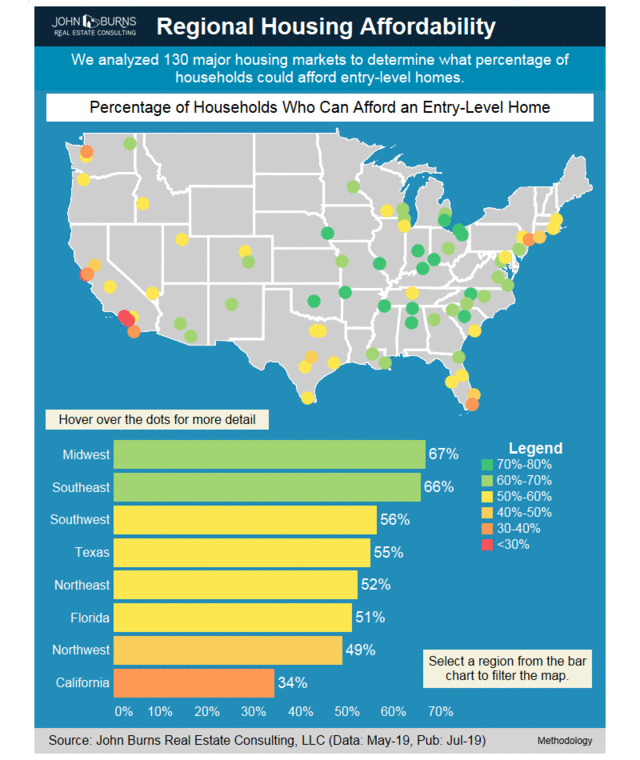Only 54% of Americans Can Afford a Home
/By Trevor Tetzlaff, Senior Research Analyst, and Jeff Hallam, Business Intelligence Developer
In the 130 metro areas we analyzed, only 54% of Americans can afford a home priced 20% below the median home price in their area—a reasonable proxy for an entry-level home¹. The recent plunge in mortgage rates to 3.7% from 4.9% in November added just 3% to that affordability figure. In California, only 34% can afford a home, with San Francisco and San Jose least affordable, at only 11% and 18%, respectively. The most affordable market is Allentown, PA-NJ, where 77.4% of residents are able to purchase a home using our criteria.
Click here or on the graphic below to open the interactive map in your browser. (The map is not interactive in the e-mail message.)
The above map illustrates our findings on a more granular level and shows current affordability for coastal and major markets.
Because of this affordability gap for would-be homeowners, many smart investors continue to invest in rental homes. Individual investors can also now capitalize on this trend and buy homes, or even partial interests in homes, online through companies like Roofstock. This strategy of investing in rental homes is responsible for the hottest new home development craze: newly built rental home neighborhoods, an opportunity we first identified in 2015. Helping fuel the rental demand is the recent Tax Cut and Jobs Act that effectively eliminated the tax benefits of homeownership.
In the table below, we highlight seven major markets and the change in affordability seen from November to now.
The percentage of households that can afford to buy a home in these seven markets increased by an average of 3.0%. That’s a lot of households (over 375,000) that could now find themselves in a position to buy. And while this cohort of new potential buyers is large, home prices are still high enough that many are choosing to continue renting.
In conclusion, we see positive short-term trends for homeownership and positive long-term trends for rental homes.
Ownership: The plunge in mortgage rates has created homeownership possibilities for 2.7 million more households as well as move-up possibilities for current homeowners with enough equity. This will spur home-buying activity this year, possibly averting the decline in volume we have been forecasting.
Renting: The lack of affordability nationwide will keep pushing more demand toward renting, especially in the most expensive markets. Very few homes exist that were purposely built with renters in mind—an opportunity that many companies are now seizing.
Whether you are a company looking to invest in homeownership, rental housing, or both, our team will be happy to help you with your analysis.
¹Our calculations assume the most common type of entry-level financing through FHA: 5% down and a 30-year fixed rate mortgage with mortgage insurance. We also include property tax payments.



